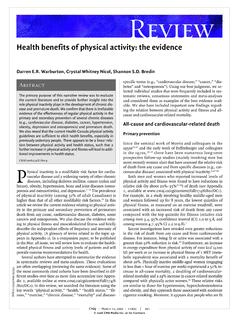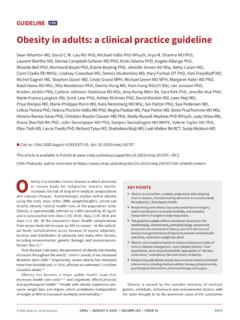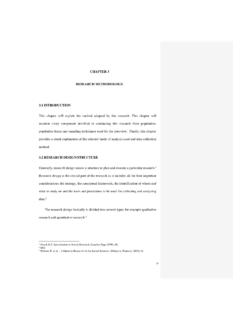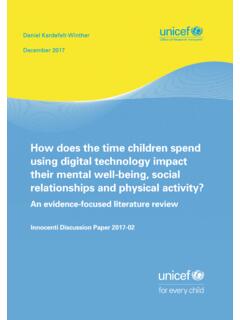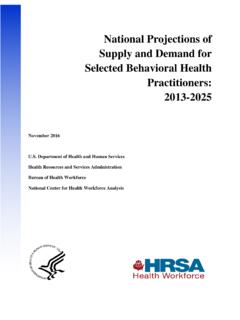Transcription of Smartphones, social media use and youth mental health
1 ANALYSIS mental health CPD. Smartphones, social media use and youth mental health Elia Abi-Jaoude MSc MD, Karline Treurnicht Naylor MPH MD, Antonio Pignatiello MD. n Cite as: CMAJ 2020 February 10;192:E136-41. doi: CMAJ Podcasts: author interview at I. n the last decade, increasing mental distress and treatment for mental health conditions among youth in North America KEY POINTS. has paralleled a steep rise in the use of smartphones and Evidence from a variety of cross-sectional, longitudinal and social media by children and adolescents. empirical studies implicate smartphone and social media use in In Ontario, the proportion of teenagers reporting moderate to the increase in mental distress, self-injurious behaviour and serious mental distress increased from 24% in 2013, to 34% in 2015 suicidality among youth ; there is a dose response relationship, and to 39% in 2017,1 with parallel increases in health service utiliza- and the effects appear to be greatest among girls.
2 Tion. Inpatient hospital admissions of children and adolescents for social media can affect adolescents' self-view and interpersonal relationships through social comparison and negative mental health reasons increased substantially across Canada interactions, including cyberbullying; moreover, social media between 2007 and 2014, while admissions for other medical condi- content often involves normalization and even promotion of tions in this age group decreased by 14%.2 Between 2009 and 2014, self-harm and suicidality among youth . admissions to hospital for intentional self-harm increased by 110% High proportions of youth engage in heavy smartphone use and in Canadian Suicide is now the second leading cause of death media multitasking, with resultant chronic sleep deprivation, for Canadian A recent analysis of survey data found the and negative effects on cognitive control, academic performance 12-month prevalence of suicidal ideation, attempts and nonsuicidal and socioemotional functioning.
3 Self-injury to be , and , respectively, among adoles- Clinicians can work collaboratively with youth and their families, using open, nonjudgmental and developmentally cents aged 14 to 17 years, with all rates being higher in Simi- appropriate approaches to reduce potential harms from social larly, administrative data in the United States show that presenta- media and smartphone use, including education and practical tions to hospital for suicidal ideation or attempts among children problem-solving. and adolescents almost doubled between 2008 and 2015, with the There is a need for public awareness campaigns and social highest increase for adolescent Self-poisoning rates among policy initiatives that promote nurturing home and school 10- to 18-year-olds, which had declined in the US since the turn of environments that foster resilience as youth navigate the the century, increased substantially from 2011 to 2018, primarily challenges of adolescence in today's world.
4 Among Surveys of high school students in the US have shown a similar pattern for self-reported symptoms of depression, major depressive episodes and suicidality over the last 2 ,9 are observational, making causality difficult to establish, findings At the same time, social media use has increased markedly. In from a few longitudinal, randomized and controlled studies suggest the US, the proportion of young people between the ages of 13 that social media and smartphone use may be contributing to the ris- and 17 years who have a smartphone has reached 89%, more ing burden of mental distress among youth . We consider the clinical than doubling over a 6-year period; moreover, 70% of teenagers implications of existing evidence, to help practising clinicians to work use social media multiple times per day, up from a third of teens collaboratively with youth and families to mitigate potential negative in The percentage of Ontario's teenagers who reported effects of social media and smartphone use on mental health .
5 Spending 5 or more hours a day on social media increased from 11% in 2013, to 16% in 2015 and to 20% in An analysis of How has use of social media been shown to Australian longitudinal data found that 86% of students owned affect adolescents' sense of self? smartphones in grade 8, increasing to 93% by grade 11, with increased use of social media communication with Two cross-sectional surveys of American and German university We review the evidence that links smartphone and social media students, respectively,12,13 found that students who spent more use with mental distress and suicidality among adolescents. We do time on the social media platform Facebook were more likely to not review evidence for online gaming.
6 Although most existing data endorse feeling envy or sensing that others in their social E136 CMAJ | FEBRUARY 10, 2020 | VOLUME 192 | ISSUE 6 2020 Joule Inc. or its licensors network were better off than they were. The term FOMO fear establish causality. youth with lower impulse control may be of missing out has been defined as a pervasive apprehension more susceptible to deleterious effects of media multi tasking. A. that others might be having rewarding experiences from which large longitudinal study of adolescents who did not have signifi- ANALYSIS. one is absent, 14 and has been associated with increased stress cant symptoms of attention-deficit/hyperactivity disorder related to Facebook (ADHD) at baseline found that high-frequency digital media use A systematic review of 20 studies found that use of social was positively associated with emergence of symptoms meeting media was associated with body image concerns and disordered Diagnostic and Statistical Manual of mental Disorders 4th Edition In a randomized study, female participants reported (DSM-IV)
7 Criteria for ADHD over a 2-year follow-up period, even more negative mood after just 10 minutes of browsing their after adjusting for known F acebook account compared with those who browsed an appearance-neutral control Moreover, participants Can social media promote self-harm? who were high in appearance comparison tendency reported an increased desire to change the appearance of their face, hair or youth communicate thoughts of suicidality and self-harm behav- skin after spending time on Facebook, in comparison with those iours online, including sharing images of self-inflicted injuries. who browsed the control Explicit depiction of self-injury particularly cutting on social The nature of social media interactions, which are arm's media is common, as shown by site content studies30,31 that found length, makes negative commenting both easy and more fre- photographs or live videos of self-injurious behaviour, many of quent than in-person interactions with peers.
8 An Ontario survey which had no warnings about graphic content. Of particular con- of middle- and high school students showed that the odds of sui- cern were viewers' comments, which typically contained positive cidal ideation, plans and attempts were all significantly higher feedback or personal disclosures about self-injury experiences, and among those who had experienced cyberbullying, even after con- rarely offered encouragement or discussion of recovery. Such find- trolling for a range of potential ings show the potential for mental illness romanticizing and mes- saging that normalizes self-harm among youth . Indeed, a system- Does social media addiction exist and can it atic review that included 26 studies (using qualitative, descriptive affect mental health ?)
9 Or cross-sectional methodology ) found that social media platforms included normalization of self-harm behaviour, discussions about One study of repeat survey data from 2013, 2014 and 2015 associ- practical issues regarding suicidality and live depictions of self- ated the extent of self-reported use of Facebook with subsequent harm At the same time, there were also positive elements, poor self-reported mental health and life Concerns including providing a sense of community, suggestions for seeking have been raised about social media platforms having been treatment and advice on stopping self-harm behaviour. deliberately designed in highly sophisticated ways that use behavioural psychology, neuroscience and artificial intelligence Do the effects of smartphones on social skills to promote behavioural reinforcement and behavioural addic- affect mental health ?
10 ,21 Several cross-sectional studies have shown that high proportions of youth appear to be addicted to their smart- An observational study showed that spending more than a few phones,22,23 but there is no standard or agreed-upon definition of hours per week using electronic media correlated negatively smartphone or Internet addiction; studies have used different with self-reported happiness, life satisfaction and self-esteem, definitions and scales, varying from those that rely on behav- whereas time spent on nonscreen activities (in-person social ioural addiction criteria, to measurement of the extent of func- interactions, sports or exercise, print media , homework, religious tional impairment and level of device ,25 As such, reported services, working at a paid job)
